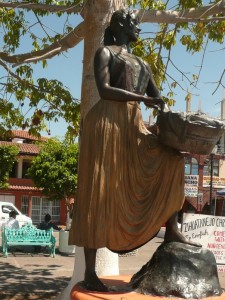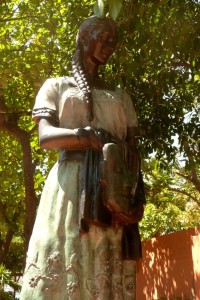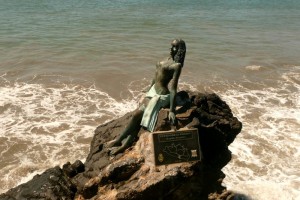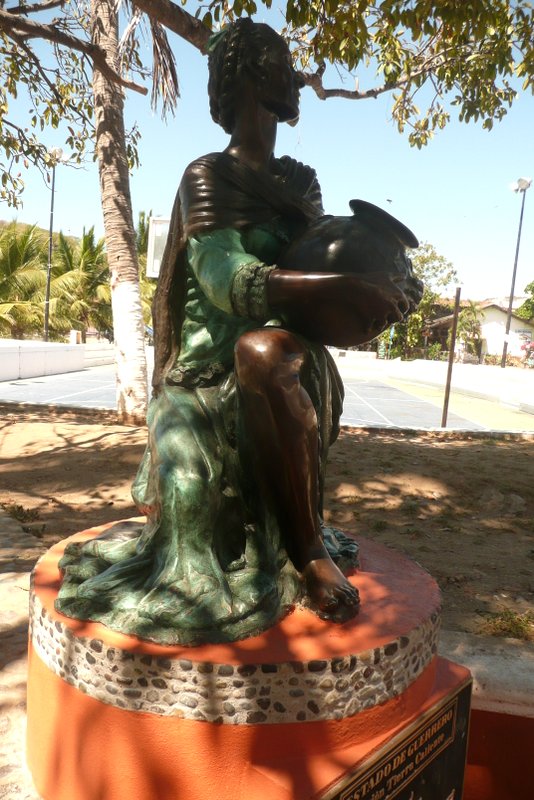For many years a series of gorgeous, life-sized statues depicting the women of the different areas of the Mexican state of Guerrero (where Ixtapa Zihuatanejo lies) with their typical regional dress, hair styles and accessories, was stationed in a park outside of the most transited sections of downtown Zihuatanejo, in a place that was unfortunately unseen and unappreciated by the public at large.
In 2010, the municipality made a fabulous decision to wipe the dust and cobwebs off of these beautiful sculptures and reposition them in key areas around the downtown core of Zihuatanejo, along the walkways and walking streets, where local residents are able to see and enjoy them daily and the tourists and visitors have the chance to learn more about the details of the Women of Guerrero and, incidentally, be able to take smiling photos stationed beside any or all of these works of art and culture.
These sculptures represent the seven geographical regions of the state of Guerrero:
1) Region Costa Grande | The Costa Grande (or Great Coast) Region

Women of Guerrero Statues in Zihuatanejo
The Costa Grande is where Ixtapa Zihuatanejo is located. It extends from border of Michoacan southward along the Pacific coastline, where it abuts upon the Acapulco Region. Cities and towns in this region include Atoyac de Álvarez,
Coahuayutla, Coyuca de Benítez, Teniente José Azueta (Ixtapa Zihuatanejo), La Unión, Petatlán and Tecpan de Galeana.
Zihuatanejo’s Costa Grande Woman is a bit sassy-looking, standing right in the main plaza and basketball court in front of Playa Municipal, with head held high and one foot propped on a rock. On her knee is a tub full of fish. Truly a woman of the Costa Grande.
2) Region Tierra Caliente | The Tierra Caliente Region
Tierra Caliente is the region inland from the Costa Grande extending up into the mountains and abutting the states of Michoacan and Mexico. Cities and towns in this region include Arcelia, Ciudad Altamirano, San Miguel Totolapan, Ajuchitlán, Tlapehuala, Coyuca de Catalán, Zirándaro, Cutzamala del Rincón, Pungarabato and Tlalchapa.
The Woman of the Tierra Caliente sculpture is squatting elegantly in the shade of one of the equally-elegant and giant old trees next to the basketball court in downtown Zihuatanejo. A rebozo (shawl) is wrapped around her shoulders and she is holding a large round pot.
3) Region Norte | Northern Region
The Northern Region of the State of Guerrero abuts the states of Mexico, Morelos and Puebla. It is a mountainous area with a more temperate, sub-humid climate. Cities and towns include Apaxtla de Castrejón, Atenango del Río, Buenavista de Cuéllar, Cuetzala del Progreso, Iguala, Ixcateopan de Cuauhtémoc , Pedro Ascencio Alquisiras, Pilcaya, Taxco de Alarcón and Teloloapan.
Zihuatanejo’s Woman of the Northern Region sports a beautifully embroidered skirt and blouse and is holding a carved masked representative of the crafts of the area. Her long, thick hair forms a luxurious braid that cascades over her shoulder. She stands in the walkway leading to the Paseo del Pescado from the base of Calle Vicente Guerrero.
4) Region Centro | Central Region

Women of Guerrero: Regional Dress
The Central Region is the core of Guerrero and abuts on all of the other geographical areas of the state. In it is located the capital of Guerrero, Chilpancingo de los Bravo, as well as the communities of Ahuacuotzingo, Chilapa, Eduardo Neri, Leonardo Bravo, Mochitlán, Quechultenango, Tixtla de Guerrero and Zitlala.
The statue of the Woman of the Central Region of the state of Guerrero is positioned on the pedestrian walkway of Calle H. Galeana at the corner of N. Bravo. She stands proudly holding a clay vessel in one hand and lifting up the skirts of her elaborately adorned and sashed skirt with the other. She’s one of my favorites.
5) Region Montaña | The Mountain Region
The Mountain Region of the state, in the Sierra Madre del Sur, borders the states of Puebla and Oaxaca to the east, with a cooler mountain climate much of the year, although summer heat can ascend to as much as 40 C. It is an area of wonderful wood and textile crafts. Towns here include Acatepec, Alpoyeca, Atlamajalcingo del Monte,
Copanatoyac, Huamuxtitlán, Malinaltepec, Metlatónoc, Olinalá, Tlacoapa, Tlapa de Comonfort and Xalpatláhuac.
The Mountain Region of Guerrero is excellently represented by another of my favorite Woman statues that is located at the crossing of Cuauhtemoc and Pedro Ascencio streets, a main pedestrian intersection straight up and inland from the basketball court and plaza in downtown Zihuatanejo. The Woman of the Region Montaña is wearing a wonderful Huipil and is seated on a carved wooden chest typical, again, of the wood crafts of the mountain area. Her hair is in a double braid and she, too, sits with a poised and proud bearing.
6) Region Costa Chica | Costa Chica Region

Women of Guerrero: Acapulco
The Costa Chica, or Lesser Coast, of Guerrero state is the stretch of Pacific coastal plain running from Acapulco to the Oaxaca border. It is tropical and humid. Communities in this area include Ayutla, Copala, Cuautpec, Ometepec, San Marcos, Tecoanapa, Tlacoachistlahuaca, Xochistlahuaca and Cuajinicuilapa.
The Woman of the Costa Chica is, in fact, a double statue, a strong and beautiful woman with features mirroring the African influences found along this section of the coast, attired in regional embroidered dress and holding on her shoulder a jug of water, with her growing daughter in a typical huipil and braids smiling at her side. These two at stationed at the base of the municipal pier and welcome cruise ship passengers and other visitors to our port. What a spectacular greeting!
7) Region Acapulco | Acapulco Region
The Acapulco region is just that: the area encompassed by the city of Acapulco de Juárez, with its spectacular bay that has captured the attention of many from pre-colonial times to the present and that separates the Costa Grande region to the north from the Costa Chica to the south.
The Acapulco Woman is the embodiment of the mermaid spirit of the Pacific coast — she lolls somewhat provocatively against the rocks along the Madera Walkway, hair loose and curly from the salt spray and clad only in a scant bathing suit and a pareo tied around her waist. You can see her by walking south-east over the flood control bridge next to the museum.

Women of Guerrero: Zihuatanejo Mexico